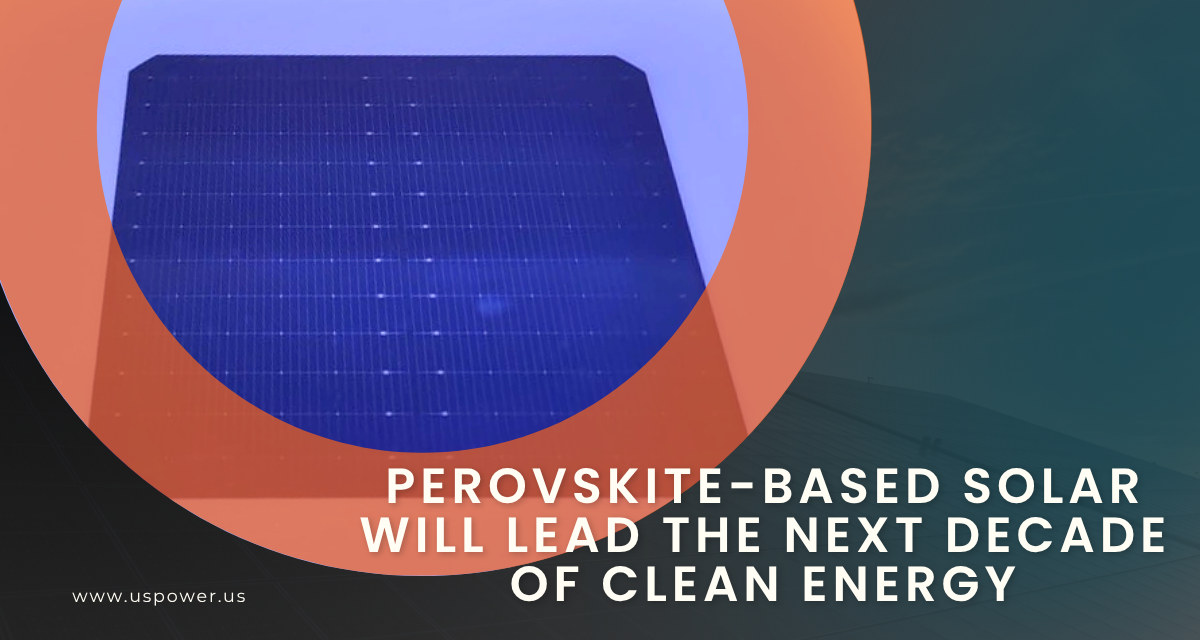The Difference Between Perovskite and Silicon Solar Cells

Solar and Roofing Advisor
The Future of Home Energy: explore the rise of tandem solar panels and see how Qcells through US Power lead California’s solar innovation.
Southern California continues to lead the clean energy movement—but with solar technology evolving fast, homeowners are now asking: Should I wait for perovskite panels, or install proven silicon panels today?
The answer is both exciting and practical. Perovskite-silicon tandem solar cells are rewriting efficiency records in 2025, while high-performance silicon panels from Qcells, installed by US Power, already deliver unmatched performance for California rooftops.
If you’re considering solar, this is the year to make your move. Incentives are still strong, and innovation is making solar smarter, more affordable, and more durable than ever before.
Solar Technology in 2025: A Quick Look at What’s Changed
In 2025, solar power isn’t just about cutting costs—it’s about embracing the next generation of renewable energy. Traditional crystalline silicon panels remain the global standard, but perovskite-based solar cells are emerging as the next big step in solar science.
According to the U.S. Department of Energy (DOE), solar photovoltaic (PV) systems now account for over 6% of U.S. electricity generation, a number expected to double within five years as new materials like perovskite improve performance and reduce costs (Energy.gov, 2025).
And while perovskite technology is still maturing, Qcells, one of the world’s most trusted solar brands, has already achieved a world-record 29.6% efficiency using perovskite-silicon tandem cells, verified by the National Renewable Energy Laboratory (NREL).
Understanding Perovskite Solar Panels
Perovskite solar panels are built using a crystal-structured material similar to the naturally occurring mineral calcium titanate (CaTiO₃). This structure allows the material to capture a broader spectrum of sunlight compared to silicon alone.
Advantages of Perovskite:
- High efficiency potential – absorbs a wider range of sunlight.
- Low manufacturing cost – made through simpler chemical processes.
- Lightweight and flexible – adaptable for building-integrated applications.
However, the biggest challenge with perovskite cells is durability. Early versions degraded quickly under humidity and high temperatures—conditions typical in many parts of Southern California. That’s why most perovskite research is now focused on hybrid or “tandem” cells, combining perovskite’s high absorption with silicon’s proven stability.
Silicon Panels: The Gold Standard for Homes
For now, silicon-based panels remain the top choice for residential installations across the U.S., and especially in California.
There are two main types:
- Monocrystalline panels – made from a single crystal structure, offering high efficiency (20–23%) and a sleek appearance.
- Polycrystalline panels – slightly less efficient but more affordable, made from multiple silicon fragments.
The Qcells Q.TRON and Q.PEAK DUO BLK ML-G10+ panels, installed by US Power, offer up to 22.5% efficiency and include anti-reflective coatings, heat tolerance, and black-on-black designs ideal for California rooftops.
With warranties up to 25 years, silicon panels have proven reliability, durability, and consistent production—qualities that perovskite still has to match.
The Future: Perovskite-Silicon Tandem Panels
The most promising solar innovation of 2025 is tandem solar technology—a fusion of perovskite and silicon layers that capture different parts of the sunlight spectrum.
How It Works:
- The top perovskite layer absorbs high-energy blue light.
- The bottom silicon layer captures red and infrared light.
- Together, they produce more electricity per square foot than either material could alone.
This design isn’t just theory. Hanwha Qcells has already developed scalable tandem cells that could reach the market within the next few years (Qcells Blog, 2025).
For Southern California homeowners, this innovation means that soon, the same rooftop space could generate 30% more power—a huge leap forward in solar performance.
Are Perovskite Panels Ready for Homes Yet?
While lab results are remarkable, fully perovskite solar panels are not yet ready for residential use. Their lifespan and moisture sensitivity still pose challenges for real-world conditions. However, tandem cells using perovskite and silicon together are already entering pre-commercial trials.
Until then, high-efficiency silicon panels remain the most reliable and cost-effective choice for homeowners—especially when installed by trusted local experts like US Power.
Here’s why homeowners shouldn’t wait:
- The 30% Federal Solar Investment Tax Credit (ITC) remains active through 2025.
- The California Self-Generation Incentive Program (SGIP) still provides rebates for solar battery storage installations.
- NEM 3.0 (Net Energy Metering) allows homeowners to receive credits for excess energy sent to the grid, though compensation rates are expected to decline further in future updates.
(All incentive details verified as of October 2025 from Energy.gov and CPUC updates.)
Comparing Perovskite vs. Silicon Solar Panels
| Feature | Perovskite | Silicon (Monocrystalline) |
|---|---|---|
| Efficiency Potential | Up to 33% (theoretical) | 20–23% (commercial) |
| Durability | Moderate, improving | Excellent (25–30 years) |
| Production Cost | Low (experimental) | Moderate (mature) |
| Availability (2025) | Limited | Widely available |
| Best Use | Research & Hybrid Panels | Home installations |
Verdict: Perovskite is the future—but Qcells’ advanced silicon technology available today already provides homeowners with top-tier efficiency, aesthetic design, and reliability.
Local Relevance: Why Southern California Homes Benefit Most
Southern California’s warm, sunny climate is perfect for solar production. Cities like Sherman Oaks, Pasadena, and Orange County average more than 280 sunny days per year, providing ideal conditions for maximum solar yield.
Pairing Qcells panels with battery storage systems allows homeowners to store excess energy for evening use—an essential advantage under the new NEM 3.0 structure. US Power integrates battery storage with every installation, offering complete energy independence and grid resilience.
Why Choose US Power and Qcells
US Power is a trusted Southern California solar installer with a direct partnership with Qcells, offering:
- Factory-direct pricing on American-made Qcells panels.
- Exclusive access to next-generation, high-efficiency technology.
- Local expertise in permitting, installation, and utility programs.
- Comprehensive system design that integrates solar, battery storage, and aesthetic appeal.
By working with US Power, homeowners benefit from local knowledge, transparent pricing, and the assurance that their systems are built for longevity and backed by a globally recognized solar manufacturer.
Should You Wait or Install Now?
While the future of solar is exciting, waiting for “next year’s model” often means missing out on today’s incentives and months of potential savings.
Installing a system now ensures you:
- Start saving on energy immediately.
- Qualify for current 30% ITC incentives.
- Enjoy fixed rates before new equipment costs rise with advanced materials.
- Future-proof your home for tandem upgrades as the technology evolves.
With US Power and Qcells, homeowners don’t have to choose between innovation and reliability—they get both.
The Solar Future Is Already Here
Perovskite-silicon solar technology represents the next leap in renewable energy. While pure perovskite panels are still developing, Qcells’ proven high-efficiency silicon panels already integrate the best available advancements today.
By partnering with US Power, homeowners in Southern California gain access to factory-direct Qcells systems built for long-term value, outstanding performance, and the best aesthetics in the industry.
Don’t wait for the next breakthrough—your home can already harness it.
Schedule your free solar consultation and discover how much you can save before the year ends.
Frequently Asked Questions
Related Articles
Our Related Blogs
Discover how Qcells’ perovskite solar tech could redefine energy in California.
QCells panels deliver reliable performance even in California’s harsh conditions.
Discover why US Power homeowners prefer QCells for long-lasting solar energy.








We empower communities and businesses to harness clean, renewable solar energy solutions that drive sustainable growth.
Ready to Own Your Power? Call us today!
818-650-8010
Copyright © 2025 US Power - Axia by QCells. All Rights Reserved.
Privacy is important to us, so you have the option of disabling certain types of storage that may not be necessary for the basic functioning of the website. Blocking categories may impact your experience on the website.
Essential
These items are required to enable basic website functionality.
Personalization
These items allow the website to remember choices you make (such as your user name, language, or the region you are in) and provide enhanced, more personal features.
Marketing
These items are used to deliver advertising that is more relevant to you and your interests.
Analytics
These items help the website operator understand how its website performs, how visitors interact with the site, and whether there may be technical issues.
We and our third-party partners use cookies and other technologies to enhance and track your experience on this site, conduct analytics, and personalize marketing to you. By using the site, you agree to our use of these technologies, including recording and monitoring your interactions with the site.
Get an instant solar estimate using satellite!









